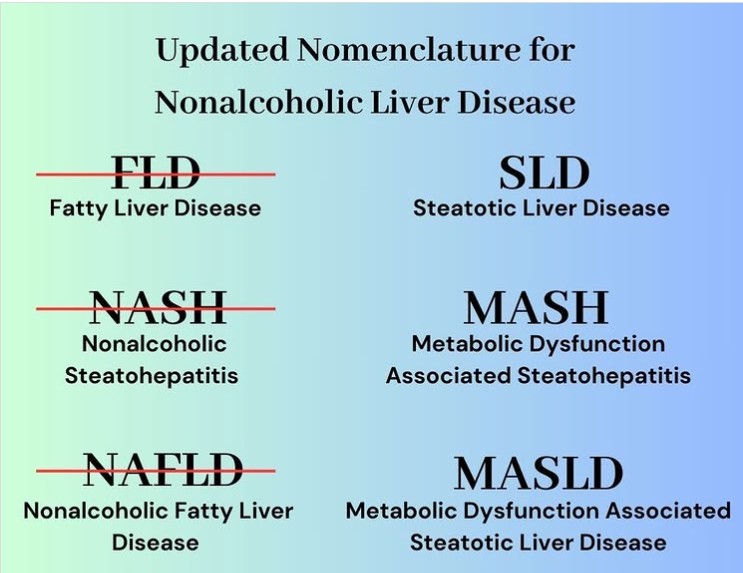- Date Published:
- Category: Blogs, Liver, News & Updates
Fatty Liver Disease Gets A New Name
This month marks two years since it was announced that fatty liver disease and its subcategories were getting updated nomenclature (names). Let's take a quick look at the revised names so that as you see them appear more frequently online and in articles you are familiar with them.
What are the new names?

- Steatotic Liver Disease is now the term that encompasses the various etiologies (the cause/set of causes) of steatosis
- Steatosis means an increased buildup of fat in liver cells
- A "fatty liver" has a medical name of hepatic steatosis
- Non-alcoholic fatty liver disease (NAFLD) was changed to metabolic dysfunction-associated steatotic liver disease (MASLD).
- MASLD is defined by the presence of hepatic steatosis with at least one of five cardiometabolic risk factors:
- BMI > 25
- Prediabetes/Diabetes
- Hypertension (high blood pressure)
- Hyperlipidemia (high blood sugar)
- Low HDL Cholesterol
- MASLD is defined by the presence of hepatic steatosis with at least one of five cardiometabolic risk factors:
- MetALD (MASLD and increased alcohol intake) is the new term for patients with MASLD who consume high amounts of alcohol per week, (140 g/week in females and 210g/week in males)
- Called "Met A-L-D"
- 140g of alcohol = approx. 10 drinks
- 201 g of alcohol = approx. 15 drinks
- NASH was replaced with Metabolic dysfunction-associated steatohepatitis (MASH).
- Patients with no metabolic risk factors or other identifiable cause(s) of steatosis are now categorized as cryptogenic steatotic liver disease.
Source: American Association for the Study of Liver Diseases (AASLD)
Why did the names change?
Able to more accurately reflect the cause of the disease
For example, the new name MASLD, recognizes that fatty liver disease is often linked to metabolic problems like obesity, diabetes, and insulin resistance, which are all part of metabolic syndrome.
Decrease the stigma
The term "fatty liver" can make a person feel labeled as it suggests a link to unhealthy lifestyle choices. The new name avoids this stigma by focusing on the metabolic dysfunction rather than the accumulation of fat in the liver.
Better able to represent the disease spectrum
The new nomenclature allows for a better understanding of the disease spectrum, taking into consideration various causes and degrees of severity.
Improved communication and patient understanding
The new name is considered more informative and less confusing for patients, helping them understand the underlying causes and potential risks associated with fatty liver disease.
Have you or a loved one recently been diagnosed with a fatty liver disease? Check out our Disease Guide to learn more.


